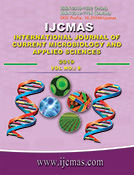


 National Academy of Agricultural Sciences (NAAS)
National Academy of Agricultural Sciences (NAAS)

|
PRINT ISSN : 2319-7692
Online ISSN : 2319-7706 Issues : 12 per year Publisher : Excellent Publishers Email : editorijcmas@gmail.com / submit@ijcmas.com Editor-in-chief: Dr.M.Prakash Index Copernicus ICV 2018: 95.39 NAAS RATING 2020: 5.38 |
Relay cropping may play an important role for crop productivity and environmental sustainability in modern agriculture if its proper timing of sowing of relay crop system is standardised. A field study was carried out during 2016-17 at the Central Research Farm of the Bidhan Chandra Krishi Viswavidyalaya with seven treatments where jute as relay crop (sown in between 15, 20, 25, 30, 35 days old mungbean) was compared with sole jute and sole mungbean. Jute equivalent yield of the relay crops was 81% and 74% higher than sole jute and sole mungbean when jute was sown on in between lines of 15 days old mungbean. This was 78% and 71% higher when jute sown on 20 day after mungbean sowing than sole jute and sole mungbean, respectively. Net returns in relay crops sown 15 and 20 DAS mungbean were 144% and 129% higher respectively than that of sole jute. Relay system when jute sown at 15 DAS of mungbean was the most energy use efficient system (EUE Econ. - 6.06 and EUE Biol. – 7.14) followed by when jute sown at 20 DAS of mungbean (EUE Econ. – 5.12 and EUE Biol. – 6.79). The highest LER (1.69) was observed in sowing jute after 15 DAS along with 13% weed smothering efficiency followed by when jute is sown after 20 DAS with 1.64 LER and 21% weed smothering efficiency. Just after Norwester rain, mungbean can be sown in line and subsequently jute can be sown in between the lines of mungbean after 15-20 DAS on the same field as relay crop for higher system productivity and return owing to low weed incidence in jute, higher organic matter addition from mungbean straw and shaded jute leaf, cost reduction in jute on land preparation and weeding. This remunerative and ecologically beneficial relay system could have the potential to economise jute production cost and to increase the pulse production in the existing jute areas of upland and medium land situation of Eastern IGP.
 |
 |
 |
 |
 |